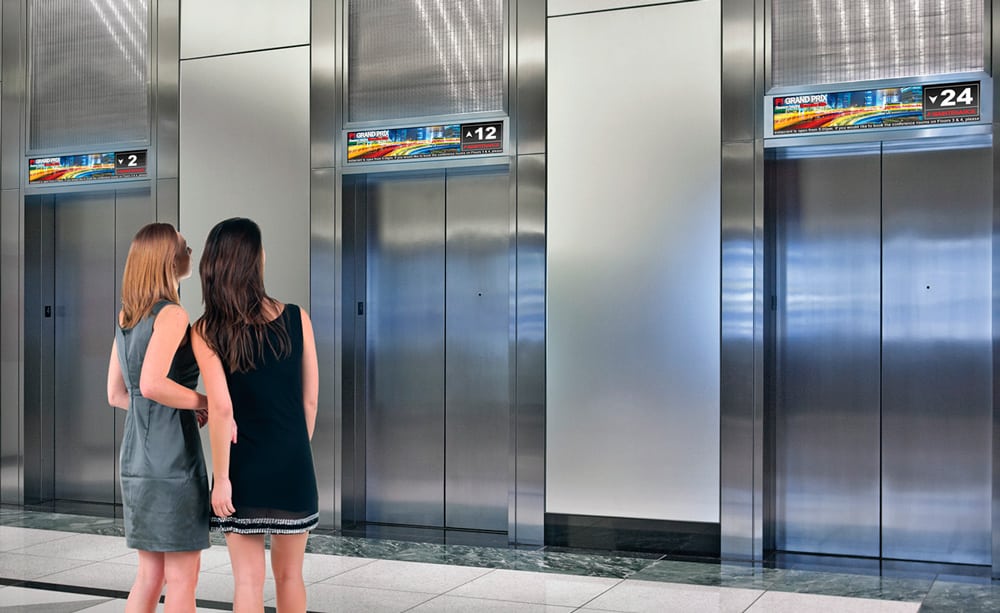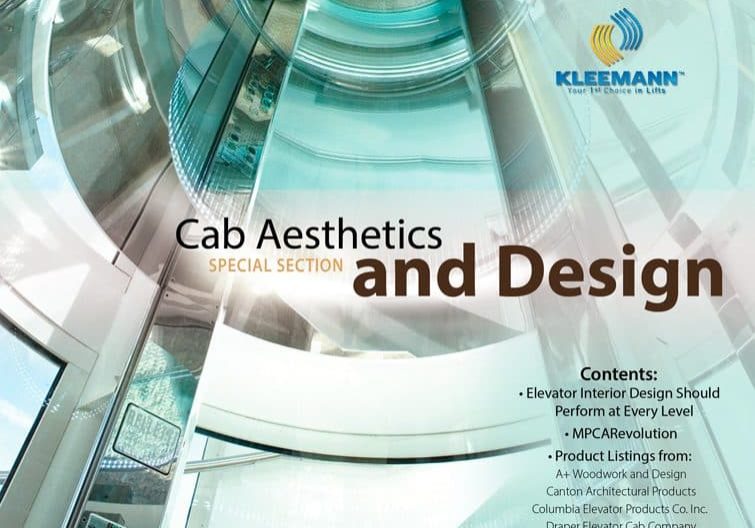Enhancing Cab Aesthetics with Multimedia Displays
Aug 1, 2014

How to choose the right display for your project
by Bill Appelbaum and Jeff Weggeland
Display screens have become a pervasive part of everyday life. We see them in use at automated teller machines, restaurants, hotels, office-building lobbies and, increasingly, in elevators. Buildings have been using this technology for years in directories. Restaurants are changing menus with the click of a mouse. More and more outdoor advertising has gone digital, accelerating the rate of change of the ads and eliminating the need for a “sign guy” to brave the heights of roadside billboards with a roll of new content to install.
Likewise, LCD displays are becoming a popular enhancement in elevators, with uses ranging from elevator position and direction to custom content delivering a wide range of communication to passengers. The primary consideration in choosing the right display is the purpose. What do you want to accomplish? You may choose to display elevator information, entertainment, news, advertisements or all of the above. Once you have established your purpose, a number of options should be considered for the best match with your goals.
Location and Orientation
The first consideration is location — where do you want the screen to be mounted inside the cab? It can be mounted on the main or auxiliary car panel, in the transom above the doors or on the side wall. When choosing a location, you should consider placement relevant to other design elements, as well as maximum visibility for passengers. Installation on the back wall is not recommended, since passengers walk in and turn around, facing the front to press the floor buttons.
The more flexible the software, the less limited your opportunities for customization.
Most screens can support both landscape and portrait layouts. Landscape is the more popular option, but if there are space restrictions in your elevators, portrait can be a good option, as well. Especially with larger screens, a portrait mounting filling an entire side panel can make a bold design statement.
Screen Size
Once you’ve determined location and orientation and know how much space you have to work with, you can select a screen size. Standard screen sizes are 10.4, 12, 15 and 19 in. These economical screens work well for basic content delivery and are ideal for projects with budget or space restrictions.
New wide-screen products are available in 19, 28, 38, and 49 in. These wider screens are better suited to the narrow spaces inside elevator cars and can accommodate more varied content. A screen that goes across the whole elevator transom, versus a smaller screen centered above it, is far more eye catching and lends a more high-end feel to the space. An “ultra-wide” aspect ratio means several different pieces of information can be displayed without appearing crowded or being too small for passengers to view comfortably.
Mounting
There are a couple of mounting options for elevator displays. Flush mounting behind the cab panels lends a sleek custom look. This is best incorporated into new construction, although retrofitting is possible. Surface mounting cuts installation time and cost, making it the most effective choice for upgrades and renovations. In either type of mounting, the choice of frame and trim material and finishes can match the cab, or add contrast in stainless steel, powder-coated black or a custom finish. For instance, wood trim integrates the modern display screen more seamlessly with a traditional wood-paneled cab.
Viewing Angle
LCD display screens are available with various viewing angles, which is an important indicator of screen quality. The wider the viewing angle, the greater the number of passengers who will be able to view the content. The most basic screens start at 100-130° and are only clearly visible to people standing at a few “correct” spots within the elevator. A viewing angle of 180° is the best choice, as it affords the ability to see the screen clearly from every angle inside the elevator.
Content Control
Several available options on the market come with automated content delivery. Automated content can consist of preselected advertisements, generic news and infotainment programmed offsite and streamed from web-based servers. While convenient, it has drawbacks: the property owner won’t have any responsibility for keeping content fresh and new, but also won’t have the luxury of content tailored to building occupants. Many advertisements have no relation to the building or its audience and serve only a small financial benefit to the property owner.
For example, if you have a hotel with a high percentage of business travelers, they’re probably interested in financial news; if a property caters to tourists, they likely want to see information about local attractions. Automated programming doesn’t allow the flexibility to meet these needs. If you want to take control of your screen content and delivery, look for a system that supplies screen-content management software.
One of the most engaging types of content available in elevator screens is video.
Updating Content
Screen-content software enables you to select and edit the screen layout, backgrounds, color schemes and graphics. Look for systems with an intuitive interface that run on a user friendly platform, such as Windows. This makes design and updating easy for laypeople. You should not need to be a graphic designer to operate the system. The more flexible the software, the less limited your opportunities for customization. Systems that offer time-based programming can run standard news and information during the day, then switch to promoting the property’s dining and entertainment attractions at night. A hotel could drum up late-night room-service orders with images of wine and cheese and other snacks running after dinner hours.
The number of elevators and groups of elevators in your building may dictate the method used to update the displays. Screens can be updated individually at each elevator with a USB drive, which works well on smaller properties. Larger properties may choose a central location within the building to update several displays simultaneously via a wired network. Some software also allows updates remotely via the Internet, which works for installations of any size.
Choosing Content
Displays can be interfaced with the elevator controller and programmed to provide a variety of information and entertainment: live TV feeds, video clips, animations, still ads, stock-market tickers, time, date, weather, and any combination of fixed or variable text messages. Screens can also be tied to the elevator controller to display floor number and direction of travel. Supplemental content such as floor directories, specific advertisements, graphics and text can be synchronized to appear on certain floors. This is a popular feature in use in many hotels, hospitals, office buildings and retail stores.
Another popular use in multipurpose properties is advertising special events, such as concerts, meetings and building-system testing. These announcements can range in design from customized graphics and scrolling text to a simple static calendar or schedule. The use of displays streamlines communications for building management, eliminating the need to post signs around the facility or manage email lists.
One of the most engaging types of content available in elevator screens is video. Screens can be programmed to run recorded videos or stream live TV via coaxial cable. Popular choices include news, weather, the stock market and sports.
Finally, elevator display screens can provide property owners with revenue-generating opportunities by selling advertising in their elevators to local businesses. Additionally, this method can increase revenue for businesses within a property by advertising on-site restaurants, bars or retail outlets.
With customizable content and a wide range of purposes, LCD screens will be a more common feature in elevators. By selecting the right combination of features and content, multimedia screen use can enhance building aesthetics, streamline building operations, generate revenue and enhance visitor experience.
Get more of Elevator World. Sign up for our free e-newsletter.









